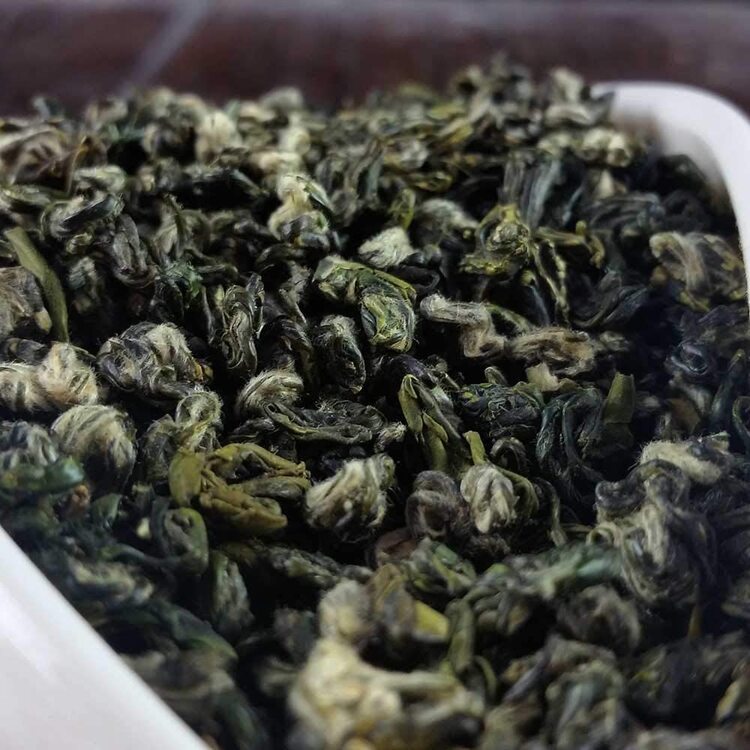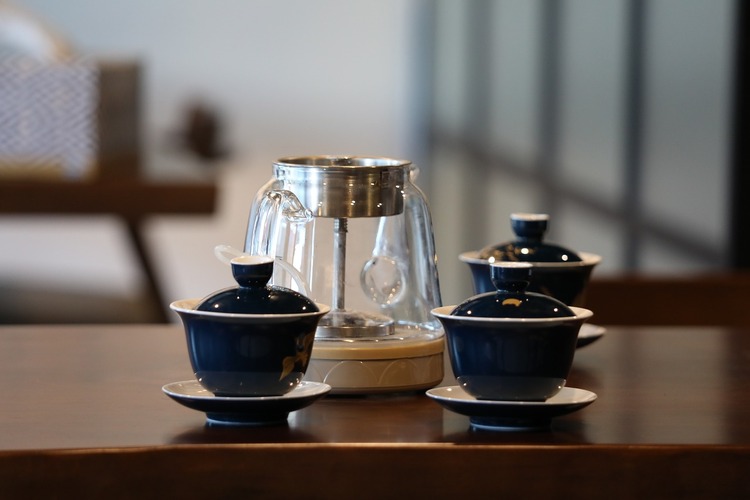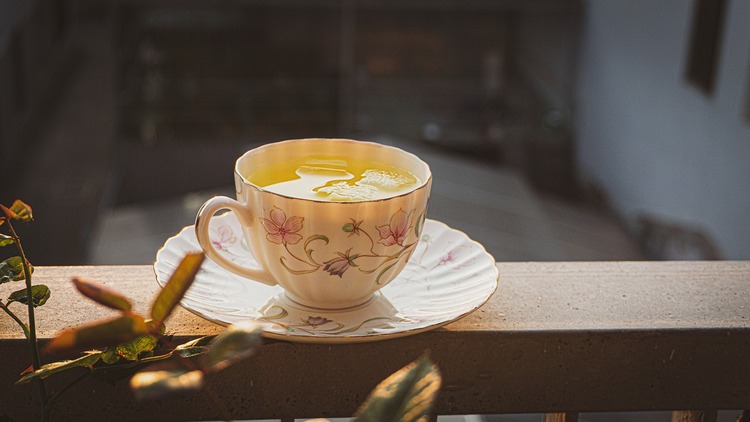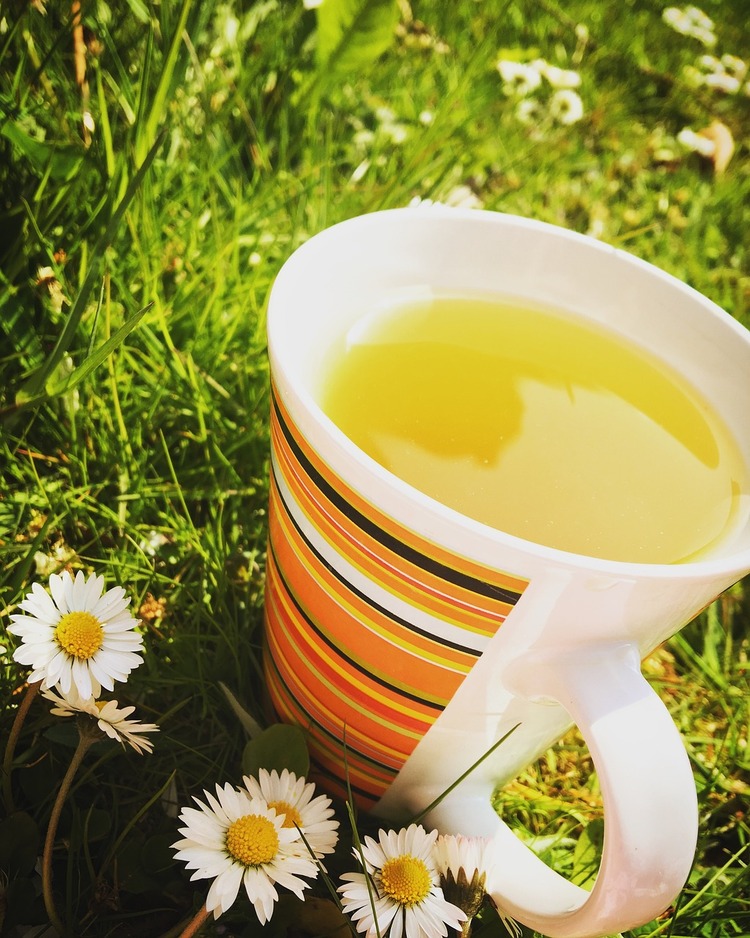Bi Luo Chun tea is known for its delicate and refreshing taste, and it has a long and fascinating history that adds to its appeal.
Bi Luo Chun tea, also known as Pi Lo Chun or Green Snail Spring, is grown in China’s Jiangsu province. It’s made from the tea plant’s youngest and most tender leaves, picked in early spring. The leaves are then hand-rolled into small spirals, which gives the tea its distinctive shape and name.
Keep reading since we have tons of information to share about this highly-regarded green tea.
Please note: This article contains affiliate links, meaning I may earn a commission if you make a purchase by clicking a link. Of course, this comes at no extra cost to you and helps me keep offering readers solid information.

Origin of Bi Luo Chun Tea
Bi Luo Chun tea has a long and fascinating history that dates back to the Tang Dynasty.
According to legend, a tea picker named Wu Lizhen discovered the tea while picking tea leaves in Dongting Mountain in Jiangsu Province. She noticed that the leaves had a unique spiral shape, similar to that of a snail, and decided to try brewing them. The resulting tea had a delicate flavor, and Wu Lizhen knew she had discovered something special.
Over time, the tea became known as Bi Luo, which means green snail or green seashell. Chun means spring, the time of year when leaves are picked. Therefore, the name per se means “green snail spring.”
The tea was highly prized by the emperors of the Ming and Qing dynasties, and was even given as a tribute to the imperial court. In fact, it is said that the Kangxi Emperor was so impressed with the tea that he gave it its current name.
Today, Bi Luo Chun is still grown in the same region where it was first discovered, on the shores of Lake Tai in Jiangsu Province.
Production Process
Bi Luo Chun is a type of green tea. The leaves of the bush used to produce this tea (a cultivar called Fuding Da Bai) are small and curled, giving it a distinctive shape that is easy to recognize.
To create a flavorful Bi Luo Chun, the production process involves several steps.
It all starts with the careful selection of tea leaves. Only the tender buds, which are the youngest and smallest leaves on the tea plant, are picked. These buds are known to have the most concentrated flavor and aroma.
After picking, the tea leaves undergo a quick withering process to remove any excess moisture, making them more pliable for the subsequent rolling process.
The withered leaves are briefly cooled down to halt any oxidation that may have begun during the withering process. In some cases, heat is applied to stop the oxidation process.
Next, the leaves are shaped into their distinctive spiral shape. This is done by hand-rolling the leaves between the palms of experienced tea artisans. The rolling process helps to release the tea’s natural oils and flavors, resulting in a more complex taste.
The rolled tea leaves are then carefully dried to stop further oxidation and fully fix their flavor. This is typically done using a combination of heat and air, with the tea being carefully monitored to ensure it is dried to perfection.
After drying, the tea leaves are sorted and graded according to their size, shape, and overall quality. The highest grade Bi Luo Chun will consist of small, tightly coiled leaves with a silvery appearance.
Before packaging, the tea undergoes a final inspection to ensure it meets the desired quality standards.
It’s worth noting that the traditional production process of Bi Luo Chun involves minimal processing to preserve the delicate flavors and aromas of the tea. This artisanal approach is part of what makes this tea one of the most sought-after and prized green teas in China and around the world

Taste Profile
Here are some characteristics of the flavor profile of Bi Luo Chun tea:
- Sweetness: Bi Luo Chun exhibits a gentle sweetness on the palate. This sweetness is not overpowering but rather subtle and lingering.
- Floral Notes: The tea has floral undertones, with hints of orchid-like or fruity-floral flavors. This adds a pleasant dimension to the overall taste experience.
- Grassy and Vegetal: Bi Luo Chun carries a slightly grassy and vegetal taste, common in many green teas. However, in this tea, these flavors are well-balanced and not overly grassy.
- Nutty: Some variations of Bi Luo Chun may have a nutty taste, which provides a pleasant contrast to the floral and vegetal notes.
- Umami: There is a subtle umami quality in Bi Luo Chun, which contributes to its savory character.
- Freshness: As a spring-harvested tea, Bi Luo Chun embodies the essence of the season.
- Smooth and Silky: The tea has a smooth and silky mouthfeel, making it enjoyable to drink and easy on the palate.
Geographical Variations
When it comes to Bi Luo Chun, the location where it is grown can make a big difference in its taste and quality. Here are some of the geographical variations to keep in mind:
- Suzhou: This is where Bi Luo Chun tea originated, and it is still considered the most authentic tea source. The tea grown in Suzhou is known for its delicate, sweet flavor and floral aroma.
- Zhejiang: Another popular region for Bi Luo Chu is Zhejiang, where the tea is grown in the mountains. The tea from this region tends to have a slightly stronger flavor and a more robust aroma.
- Sichuan: While not as well-known as Suzhou or Zhejiang, Sichuan is home to some excellent Bi Luo Chun. The tea from this region has a unique flavor profile, with a hint of smokiness and a slightly bitter aftertaste.
- Dong Shan and Xi Shan: These two mountain ranges in Jiangsu province are also home to some high-quality Bi Luo Chun tea. The tea from these regions tends to have a more complex flavor profile, with fruit and nut notes.
- Dongting Biluochun: This type of Bi Luo Chun tea is grown around Dongting Lake in Hunan province. The tea from this region is known for its strong, nutty flavor and ability to hold up well to multiple infusions.
- Yunnan: While Yunnan is more famous for its pu-erh tea, it also produces some excellent Bi Luo Chun. The tea from this region tends to have a stronger, more earthy flavor than tea from the other areas.
Brewing Bi Luo Chun Tea
Brewing Bi Luo Chun tea is a simple and enjoyable process, resulting in a delicious cup of tea. To begin, you must gather a few essential items – a teapot or gaiwan, a teacup, and some high-quality tea.
The first step in brewing is to heat your water to the correct temperature. The ideal water temperature for Bi Luo Chun tea is around 80-85°C (176-185°F). You can achieve this by bringing your water to a boil and letting it cool for a few minutes before using it.
Next, add the tea leaves to your teapot or gaiwan. The recommended amount of tea leaves is around 2-3 grams per 100ml of water. If you are using a gaiwan, rinse the leaves with hot water for a few seconds before discarding the water.
Now, it’s time to steep the tea. The recommended steeping time is around 30-60 seconds for the first infusion, and you can add 10-20 seconds for each subsequent infusion. Be sure to adjust the steeping time based on your taste preferences.
Once your tea has finished steeping, pour it into your teacup and enjoy! Bi Luo Chun tea is best enjoyed without any additives, so you can fully appreciate its delicate and complex flavor profile.

Health Benefits of Bi Luo Chun Tea
If you are looking for a healthy beverage, Bi Luo Chun green tea is an excellent choice. It is packed with antioxidants, tea polyphenols, and catechins that can help improve your overall health. Here are some of the health benefits of this tea:
- Heart Health: Can help reduce the risk of heart disease by lowering cholesterol and blood lipids. The antioxidants in the tea also help prevent arteriosclerosis and promote blood circulation.
- Weight Loss: Can help with weight loss by boosting your metabolism and fat metabolism. The caffeine in the tea also helps eliminate fatigue and can give you a boost of energy.
- Antibacterial and Diuretic: This tea has antibacterial properties that can help prevent infections. It also has a diuretic effect that can help reduce edema.
- Rich in Fluorine: Bi Luo Chun is rich in fluorine, essential for maintaining healthy teeth and bones.
- Central Nervous System: Contains caffeine, which can stimulate the central nervous system and improve mental alertness.
- Rich in Vitamin C: Bi Luo Chun tea is rich in vitamin C, essential for maintaining a healthy immune system.
Comparison with Other Green Teas
There are many varieties to choose from when it comes to green teas. Bi Luo Chun tea is one of the most popular, but how does it compare to other green teas? Let’s take a look.
Longjing Tea
Longjing tea, also known as Dragonwell tea, is another famous green tea from China. Longjing tea leaves are flat, broad, and pointed, with a distinctive “sword-like” shape. They have a smooth and even jade-green color. As we have pointed out, Bi Luo Chun tea leaves are small and curly, resembling tiny snail shells. They have a delicate and silvery appearance.
Longjing offers a chestnut-like, vegetal taste with a hint of roasted undertones. It has a more pronounced nutty flavor than Bi Luo Chun (which has a delicate, sweet, and floral flavor ).
Liu An Gua Pian
Liu An Gua Pian, or Melon Seed tea, is a green tea from the Anhui province of China. Unlike Bi Luo Chun and Longjing tea, it is made from the second leaf on the tea plant rather than the bud and first leaf. This gives it a slightly different flavor profile. Liu An Gua Pian is also roasted, which provides it with a toasty taste, whereas Bi Luo Chun is not.
Other Green Teas
There are many other types of green teas from China and other countries. Some of the most popular include:
- Sencha: a Japanese green tea with a grassy flavor
- Matcha: a powdered Japanese green tea that is whisked with hot water
- Gunpowder: a Chinese green tea that is rolled into small pellets
- Jasmine: a Chinese green tea that is scented with jasmine flowers
Each green tea has its unique flavor profile and brewing method.

Grading of Bi Luo Chun Tea
Regarding Bi Luo Chun tea, grading is a crucial aspect to consider. The grading system is used to determine the quality of the tea leaves.
Here is a basic explanation of the Bi Luo Chun grading system:
- Grade 1: This grade represents the highest quality. The leaves are young, tender, and carefully handpicked. Grade 1 Bi Luo Chun consists of small, tightly rolled tea buds with abundant silver tips. The leaves are uniform in size and shape, and the color is vibrant green with silver-white fuzz.
- Grade 2: The leaves in this grade are also carefully handpicked and consist of tightly rolled buds. While they may not have as many silver tips as Grade 1, they still exhibit a high-quality appearance with a uniform color and shape.
- Grade 3: This grade includes leaves that are slightly larger and less uniform than those in Grade 1 and 2. The color may be slightly darker green, and there could be fewer silver tips.
- Grade 4: Leaves in this grade are larger and more mature compared to higher grades. They may have a more pronounced green color and fewer silver tips.
- Grade 5: The lowest grade of Bi Luo Chun, consisting of larger and less tender leaves. The appearance may be less uniform, and there are fewer silver tips present.
It’s important to note that the grading of Bi Luo Chun is somewhat subjective and can vary among different producers and regions. Additionally, some producers may use more specific sub-grades or additional designations to further classify their teas.
Buying Recommendations
A great place to buy this tea is at specialty tea shops. These shops often carry a wide variety of tea blends. Specialty tea shops are also the place to ask questions and get recommendations from knowledgeable staff members who can help you find products according to your preferences and budget.
If visiting a specialty tea shop is not a viable option, you can look for reputable online tea shops or retailers. You can also read reviews from other customers to get an idea of the quality of the tea and the seller’s reliability.
If you are interested in buying online, please take into consideration the recommendations shown below.

Dongting Bi Luo Chun Green Tea Loose Leaf


Frequently Asked Questions
What are some other popular Chinese teas?
China is known for producing some of the best teas in the world. Some of the other popular Chinese teas include Longjing tea, Tie Guan Yin tea, Huangshan Maofeng tea, and Da Hong Pao tea.
What is the difference between Bi Luo Chun and Longjing tea?
Bi Luo Chun and Longjing tea are green teas, but they come from different regions in China. Bi Luo Chun is grown in Jiangsu province, while Longjing tea is grown in Zhejiang province. Bi Luo Chun is known for its fruity and floral taste, while Longjing tea has a nutty and toasty flavor.
What is the best way to brew Bi Luo Chun tea?
To brew Bi Luo Chun tea, you should use water that is around 175°F (80°C) and steep the tea leaves for 1-2 minutes. You can use a gaiwan, a teapot, or a mug with a strainer. It is recommended to use 1-2 teaspoons of tea leaves for every 8 ounces of water.
What are the health benefits of drinking Bi Luo Chun tea?
This tea is known for its high levels of antioxidants, which can help reduce the risk of chronic diseases such as cancer and heart disease. It is also believed to boost metabolism and aid in weight loss.
Are there any unique flavor notes in Bi Luo Chun tea?
Bi Luo Chun has a unique taste profile that is fruity, floral, and slightly sweet. Some people describe it as having a “grape-like” flavor, while others note hints of apricot, peach, and honey.
What is the history of Bi Luo Chun tea?
Bi Luo Chun tea has a long and rich history that dates back to the Tang dynasty (618-907 AD). Legend has it that a young woman named Wu Lizhen discovered the tea while picking tea leaves in the Dongting mountains. The tea was so delicious that it was offered to the emperor, who named it “Bi Luo Chun” or “Green Snail Spring” because of its unique shape and color.

I hope you have enjoyed the article and learned something new! See you later!
Have you tried this tea?
More About Green Tea
What Does Green Tea Taste Like?
What Does Jasmine Tea Taste Like?
What Does Jasmine Milk Tea Taste Like?